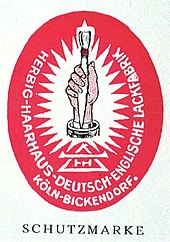Herbol
| Herbol
|
|
|---|---|
| legal form | GmbH |
| founding | 1844 |
| Seat | Cologne |
| management | Marco Sicconi, Thomas Biermann (all managing directors), Helmut Twilfer (chairman of the supervisory board) |
| Branch | Building paints, lacquers, glazes |
| Website | www.herbol.de |
Herbol is one of the oldest German brands for professional architectural paints. It has its origins in the Herbig-Haarhaus lacquer factory founded in Cologne in 1844 . The product range includes facade paints , interior wall paints , lacquers and glazes , fabrics, crack reinforcement, as well as concrete and floor systems. The coating systems are used for renovation, repair and new construction. Since 1999 the Herbol brand has been part of Akzo Nobel Deco GmbH, a subsidiary of the Dutch AkzoNobel group , the world's largest manufacturer of paints and varnishes.
history
Beginnings
The company was founded in Cologne in 1844 by Robert Friedrich Haarhaus. In 1871 his son-in-law Adolf Herbig joined the company. The paint and varnish business was expanded. After the death of Robert Friedrich Haarhaus in 1874, the company was renamed Deutsch-Englische Lackfabrik . In 1899 Arthur Herbig and Adolf Herbig Jr., the sons of Adolf Herbig senior, joined the company.
In 1903 the company moved to a new, modern production site in Vitalisstrasse in Cologne- Bickendorf , which still exists today as the German administrative center. In 1904 Herbolin Liquid Porcelain was registered as a trademark and became one of the first large German white lacquer brands alongside Kristallweiß ( Glasurit ), Eburit (Beck & Co.) and Alpinaweiß ( Deutsche Amphibolin-Werke ). In 1910 the company had 80 employees.
Expansion and war years
1910 was also produced outside of Cologne for the first time. Herbol products are manufactured under license in Vienna and Paris . In 1912 Arthur Herbig took over management of the company after his death. In 1923 a new inking plant was opened in Cologne. In 1930, 180 employees were already manufacturing around 330 different products here.
During the Second World War , the main factory was considered to be an important military operation, because camouflage colors were produced on a large scale. The Cologne plant was 70 percent destroyed after several air raids. After the German surrender , the branches in Vienna, Berlin and Milan were expropriated. Production started again in Cologne in August 1945.
post war period
In 1952 Herbol started producing emulsion paints . From 1954 synthetic resins were produced in-house in the newly built synthetic resin factory. Herbig-Haarhaus production expanded over the next ten years. New branch plants in Würzburg and Switzerland were put into operation. Hans Herbig died in 1955; for the first time there was no bearer of the traditional name Herbig. Erich Zschocke shaped the company for the next three years. The collection of the passionate lover of hand-painted porcelain and lacquer objects later together with the collection of Kurt Herberts formed the basis of the inventory for the Museum für Lackkunst in Münster . In 1957, the Herbol company logo was redesigned by the American designer Raymond Loewy ( Coca-Cola bottle, Lucky Strike ). It showed a brush with the Herbol lettering inside.
Sales and recent company history
In 1968 the Herbig family sold the company to BASF AG and Bayer AG . In 1969 the blue Herbol logo was introduced as a trademark in addition to the brush. BASF took over the Cologne and Würzburg sites completely in 1970. Renewal and expansion of the Herbol brand continued under the leadership of BASF . After extensive restructuring and the increasing international orientation of the paint and varnish industry, Herbol became part of the newly founded Deco GmbH in 1997.
In 1999, Akzo Nobel took over BASF’s European building paints and varnishes business. The newly founded Akzo Nobel Deco GmbH controlled the Herbol brand from Cologne, which is sold in many European countries. In 2007 the Herbol-Symbiotec facade paint was introduced as the “first real nano facade paint” in cooperation with the binder manufacturer BASF. Since 2010, all Herbol architectural paints have complied with the VOC regulation.
Corporate structure
The Herbol brand belongs to the Dutch AkzoNobel group. The range is sold through independent wholesalers and specialist dealers. Herbol is a recognized professional brand in many European countries, for example in Austria , Switzerland , France and Belgium . In 2009 Herbol was successfully launched in Italy . In 2011 the official introduction took place in the Netherlands.
Web links
literature
- Lothar Bartling, Gerhard Türpitz: 100 years of the Cologne-Bickendorf location . Festschrift.
Individual evidence
- ↑ a b K. Dohnke: The paint story: 100 years of color between protection, beauty and the environment . Dölling and Galitz, Hamburg 2000, ISBN 3-933374-64-2 .
- ↑ Manufacturer information about Herbol-Symbiotec. Retrieved February 14, 2011 .
- ↑ Manufacturer's information on compliance with VOC legislation. Retrieved February 14, 2011 .

